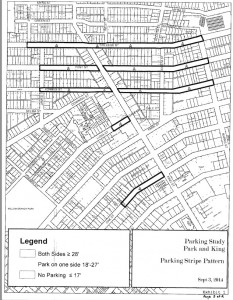Public Works given green light to move ahead with parking striping
Posted on December 1, 2014 By Editor Articles, Neighborhood News, Top Stories
With a single amendment and a unanimous vote, on Oct. 28 City Council put into place a new ordinance that is intended to address parking in two neighborhoods in District 14.
While the parking issue is at least two-fold – merchants grappling with a lack of parking for their patrons versus residents fighting to keep driveways from being blocked or, if they don’t have a driveway, on-street parking available for their own vehicles – the ordinance also addressed speed limits on certain roadways in the district and the hours of allowable parking in Avondale.
The amendment, proposed by District 6 Councilman Matt Schellenberg, suggested expanding the hours for allowable parking along Van Wert Street (adjacent to Boone Park). The original bill (2014-617) proposed by District 14 Councilman Jim Love suggested that parking along Van Wert could occur between 7 a.m. and 10 p.m., however Schellenberg proposed extending the night hours to 3 a.m., effectively providing for 20-hour parking next to the park.
“Matt [Schellenberg] had offered up the amendment because on Pine Street we’re going from two-sided parking to one-sided parking, which obviously will affect the number of parking spaces, and striping will force certain size parking places which probably will reduce parking by a little bit,” said Love. “He brought up the point that it will hurt the commercial folks at the Shoppes of Avondale.”
Schellenberg’s amendment will allow businesses’ employees as well as patrons and residents to park a few blocks from the Shoppes of Avondale for nearly an entire day.
“It’s a short walk from there to the Shoppes. Even though we’ve lost some parking we’ve gained some late night parking,” Love noted. “It will allow parking outside of the residential area and could be a place that people can park in lieu of Pine Street or on Riverside. I thought it was a fairly good compromise.”
 Striping plans
Striping plans
One of the original ideas for striping certain streets to prohibit parking – or to provide legal spaces for parking – was to “checker” the street; that is, alternate parking spots from one side of the street to the other in a checker board pattern. That option is still on the table because the ordinance was left purposely open.
“The way the bill was written says [there can be] one-sided parking along certain streets, particularly Pine Street. One-sided means it could be one-sided here, one-sided there,” stated Love. “I wanted the option to be for what makes sense.”
Kay Ehas, chair Riverside Avondale Preservation’s Parking and Transportation committee, noted that a checkered striping pattern will serve to serve slow car speed on “yield” streets.
“Yield streets serve to provide parking and calm traffic. Considering that the FDOT allows parking on both sides of a 24-foot wide street, we are being conservative in our request to stripe a checkered pattern on streets 24 to 27 feet wide,” Ehas said. “I also believe parking on only one side of the street will result in more circling when drivers find themselves going down a street in one direction only to discover that the parking spaces are on the other side of the street.”
According to Love, Jim Robinson [Public Works director] will have the ultimate responsibility with input from residents, particularly where there are no driveways. “Whatever makes sense on a safety aspect and to maximize parking. The bill is written to say ‘one side of the street,’ not which side,” Love said.
Real reason for the bill
By state law, the residential speed limit is 30 mph and the only way to change that is with an ordinance, Love explained “That’s why we had to have the ordinance. We could have striped without an ordinance,” he said.
Love added there was one caveat in the bill that gives Robinson the option to change things if there is an error or if it results in a safety issue. “Fifteen miles per hour may be too slow on Post and College, maybe not. I’m giving him the option to choose. In the residential areas, those streets need to be 15 miles per hour,” Love stated.
Ehas agreed that any changes made to residential streets were imperative to safety. “Although the street speed will be limited to 15 mph, most drivers ignore speed limits and will drive as fast as they feel comfortable doing so. Drivers going too fast is a complaint we heard over and over again from residents. Placing parking on only one side of the street, in my opinion, will make drivers feel safer driving faster.”
This striping is considered a pilot project and striping on more streets will require additional legislation. Residents have asked Public Works that the stripes not be placed using permanent Thermoplastic paint.
“Most people I’ve talked to are glad we’re organizing the parking. It will make it safer for the citizens and the rescue vehicles and I want it better for the residents so they don’t have their driveways blocked,” Love concluded. “I think the bill is good, but it doesn’t mean it’s the end-all, be-all. For now, we can do it and see how it affects things. It’s not too restrictive.”
By Kate A. Hallock
Resident Community News




 (1 votes, average: 5.00 out of 5)
(1 votes, average: 5.00 out of 5)




